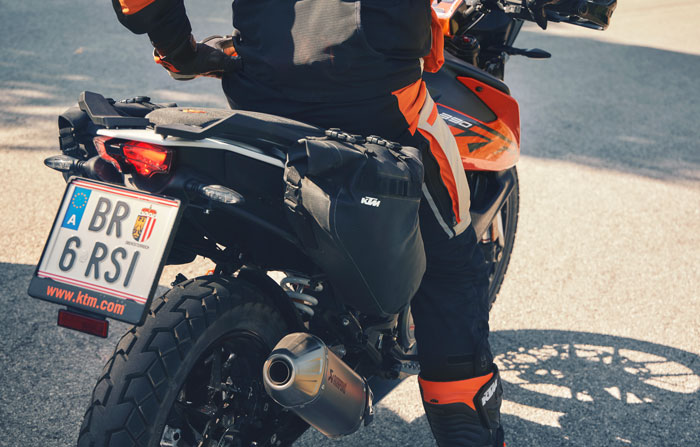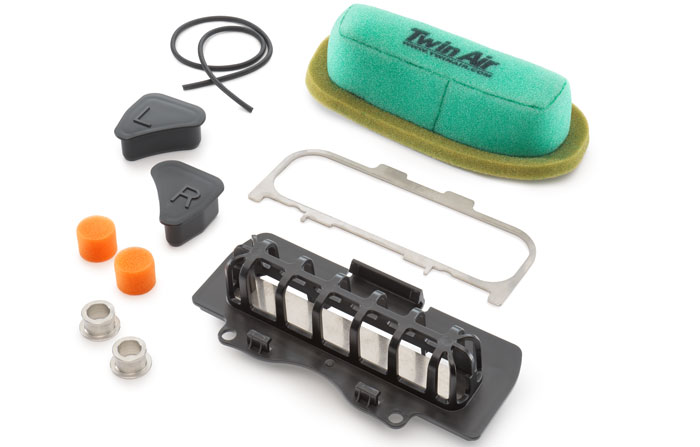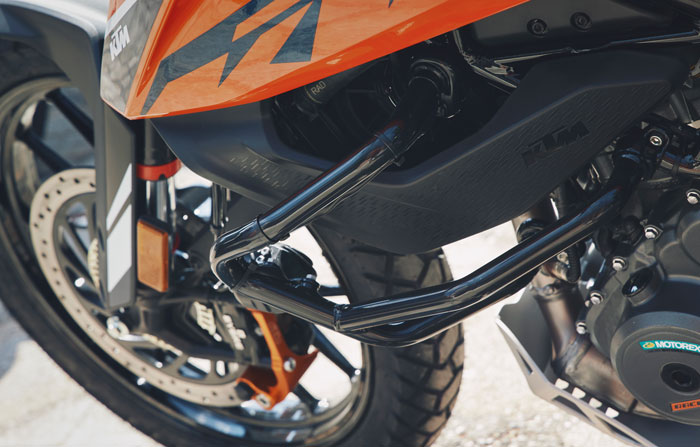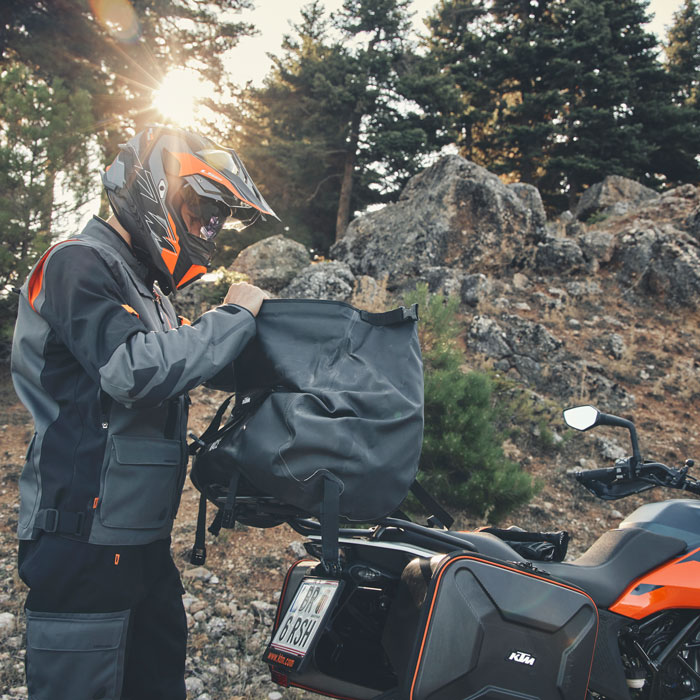PACK LIGHT, GO FAST
TIPS & TRICKS TO BETTER PREPARE FOR YOUR NEXT ADVENTURE
There are no fixed rules when it comes to packing for a motorcycle trip. But after seven long years on the road and more than 250,000 km worldwide, I came to realize that ‘less is more’, and the last thing you need to do while planning a bike adventure is to overthink. However, there are some items I believe are indispensable for a weekend away, or even a year-long trip around the world.

PC @FrancescMontero
Packing is all about making decisions and possibly the first one you need to make is whether you’ll go for a hard or soft pannier set-up. This topic is certainly a crowd splitter, and even if I personally believe soft panniers are the best for long-distance adventure traveling, there are indeed some good arguments in choosing one or the other option.
It is impossible, in fact, to deny that weight is significantly less with soft panniers and their flexibility in terms of packing is clearly superior compared to the fixed and squared storage availability in hard panniers. Hard panniers have instead an obvious advantage as they can provide an apparent extra safety for your belongings, especially when riding in urban areas, even though this is not 100% guaranteed.

PC @FrancescMontero
The How and the What
Whether you need to pack for a two-year expedition or a two-week adventure, the packing procedure doesn’t differ that much. It’s always important to consider what kind of season you are traveling through and what kind of sleeping arrangements you are going to select. The principle of packing is simple: pack light to enjoy your riding more!
Less is… definitely more in this sense. Carrying solely the essentials is key for having the least amount of drag on your riding experience. 5 to 10 kg of extra weight can make a huge difference in terms of riding sensation, hence it is important that one packs the bare minimum and keeps the heavy load strapped or stored as low as possible on the motorcycle.
Despite this being common knowledge for all, we always tend to overpack. Each one of us is different and has different needs and styles, so nobody can really tell you what to pack exactly. It is a learning process and the more you practice it, the better you will get at it. For instance, when I started my year-long journey around Australia, I had no experience at all, neither in camping nor in motorcycle traveling.

PC @FrancescMontero
I had initially packed swimming fins! That’s how inexperienced I was! Clearly, after only two weeks into my journey, I decided to give those away because I realized that it was completely unnecessary to carry those. So, do not worry if you don’t get it right the first time. Practice makes it perfect…
Sleeping in the wilderness
If you decide to go camping, the choice of quality of the equipment is absolutely fundamental. Something I learned quite quickly during my trip is that you should never save money on a sleeping mattress. There’s nothing worse than riding all day and not being able to sleep at night. Get at least a 7 cm tall inflatable mattress, insulated if possible, and do not try to save money on this one. You’ll thank me later.
Sleeping bags can be “relatively” cheap as there are multiple layers you can cover yourself with at night. Getting a big and heavy sleeping bag can be an issue when you are trying to pack, so It’s better to get a 0-15 degrees Celsius range one, which you are more likely to use in spring and autumn. For winter, you will still need to use a space blanket as an inner layer to have the warmth you need to withstand cold nights.
Emergency blankets are light, cheap, and can be stored easily, better than a bulky sleeping bag.
Regarding the tent, there are many different ways to go about it. Some people like to sleep on hammocks, others in small swags. Personally, I like to have a bit of room to store my helmet, gear, and bags in it, so I always end up buying a three-person backpacking tent, which fits me and all my belongings just fine. I am also 1,90 cm tall and in a two-person tent I end up having to sleep diagonally to fit in straight. Backpacking tents are usually around 1.5 – 2 kg maximum and can be stored inside any motorcycle panniers.

PC @FrancescMontero
A gas burner and a cooking set are also quite handy to boil water and have a light breakfast/meal once you’re set up for your stay. But I usually don’t bring any other items, except some tea and coffee bags, sugar, and my pocketknife. I always bring some plastic bags with me to collect trash and some wet wipes. A headlamp is also quite handy for the night but it’s not extremely necessary, having smartphones nowadays. Everything else is extra, really. I sometimes carry a foldable chair too, which comes in handy when wild camping. Remember that generally, you are not going to stay too long at a camp spot, unless you really want to, so all extra items are just more weight to carry on your bike.
What to wear
Selecting the right gear is arguably one of the most complicated riddles to solve for many people. But once you solve it, everything seems fine. I like to pack ultra-light and usually one 40 liters bag will suffice for me, during all four seasons. Six T-shirts, seven pairs of undies (two technical and five normal), seven pairs of socks (two technical and five normal), a pair of jeans, a pair of shorts, a hoodie, one pair of running shoes, one pair of flip-flips, a microfiber towel, and a toiletry bag.
Then, I carry one technical shirt, underpants, windbreaker from KTM to wear underneath my riding gear.

PC @PaoloCattaneo
Helmet, riding boots, and two sets of gloves, one for summer/spring and one for winter/fall. You can easily wash and dry your riding underwear (shirt, undies, and socks) every day after you arrive at your destination, and they will be dry in the morning. Especially during my winter riding days and nights in Alaska and Canada, this technical clothing from KTM was essential to keep me warm. A must-have.
Regarding riding gear, it is important to understand which season/s one is going to face while traveling. In my case, I had a four-seasons suit, which is not fully waterproof in itself but that provides great ventilation in summer/spring. The latest TERRA ADVENTURE suit was great for riding through the Alps in Autumn and towards the Pais Basques in summer. It is shower proof in itself but comes with a rainproof jacket that you can wear on top for extra waterproofness. It dries extremely quickly and it is very light, which is great for riding and walking around. Remember that less is more even in this department.

PC @RSchedl
Be ready for the unexpected
When it comes to being prepared for the unexpected, we can never really be ready 100%. It is somehow wise to always carry first aid and puncture repair kits. Modern adventure bikes will be equipped with tubeless tires, which are much easier to repair. No need to carry any tools to remove tires or special equipment to repair your bike on the side of the road, unless you are going for a year-long trip. In this case, it is quite useful to carry some extras, like a chain lube and some pliers, together with some heavy-duty gloves, duct tape and cable ties.

PC @HMitterbauer
If you are instead willing to carry some extra weight, having a portable compressor could come indeed quite handy. I’ve used mine several times when deflating and inflating my tires on sand dunes of Australia and on the golden shores of Brazil, without relying on gas stations. It is also useful in case you find somebody else on the side of the road stranded with a flat. It is very unlikely that you will have to crack open your motorcycle engine on the side of the road and if a major failure would eventually occur, you will probably have to carry/tow the bike to the nearest dealer anyway.
A lot of people I met while traveling used to carry a lot of spare parts etc., and it ends up being something that could be avoided with some proper planning and… a bit of luck. KTM authorized dealers and mechanics are available across the planet, in most capital cities. I often relied on those to retrieve and order spare parts and tires for my motorcycle. An excellent chain of distributors and resellers worldwide, like KTM one, has been a valuable asset to have during my world exploration.
Ready for any condition
There are some parts and accessories which I consider fundamental to have on a bike before starting any trip. It is quite important to equip your motorcycle with these parts to protect some crucial parts of it and extend its life. A washable Air Filter is highly recommended to protect the bike air intake from dust and all accidental debris that may enter your engine.

PC @HMitterbauer
Trust me that If I didn’t have such an air filter installed on my motorcycle from the start, I wouldn’t have been able to ride for 200,000 km with no mechanical issues! My KTM 1190 ADVENTURE’s pistons and cylinders were still in great conditions regardless of what I put my bike through for seven years. Check this article for more information: HOW TO MAKE A 200,000 KM BIKE READY TO EXPLORE THE WORLD ONCE AGAIN – KTM BLOG
A bash plate is extremely handy to protect the bike from accidental rocks, tree branches, and other objects that get projected onto your bike. It is also quite handy to be used to lift the bike up when performing emergency operations on the back or front wheel, if the central stand is not present. A radiator guard is probably the second most important accessory to have.

PC @FrancescMontero
I, unfortunately, learned the hard way about this, when in Chile a truck shot a small rock right through it. Fortunately, I was able to address the issue at once and have the guys at KTM La Serena take care of it! Handguards with metal plate are another key extra to have to protect your hands from direct wind and your brake/clutch lever from snapping, in the event of a crash. Last but not least, crash bars are absolutely necessary to protect yourself, fairings, and ultimately the tank of your motorcycle.
These last one saved me multiple times even in apparently safe situations.

PC @FrancescMontero
Like that time, I was riding in Ushuaia, Argentina, towards the nearby glaciers. I failed to notice the black ice that was laying in one corner and as soon as I hit the brakes, the bike and I were already sliding on the ground, holding on to our lives. The crash bars took all the hits and we both came out unscathed, aside from my poor ego.
It’s common knowledge that proper planning prevents poor performance. So, pack light, pack right and just go ride!
World traveler Paolo Cattaneo will be tackling THE WORLD ADVENTURE WEEK 2022 on July 4. For more info click here.



